
FIVE WITH A FALCON: Derek Tirrell, Film/Video Production (COMM '25) – Perseverantia: Fitchburg State University Podcast Network
- FIVE WITH A FALCON: Derek Tirrell, Film/Video Production (COMM '25)
- MAKING HISTORY TODAY: Media and U.S. Politics – Brian Rosenwald on Talk Radio's America
- MAKING HISTORY TODAY: Media and U.S. Politics – Matthew Delmont on Why Busing Failed
- MAKING HISTORY TODAY: Media and U.S. Politics – Matthew Pressman on the Liberal Values that Shaped the News
- MAKING HISTORY TODAY: Media and U.S. Politics – Heather Hendershot on When the News Broke
I’ve been publicizing a lot, recently. My students this semester in the Honors Seminar in History produced a digital archive of oral histories and a podcast to capture and chronicle Fitchburg State’s experiences with Covid-19.
This project was a lot of work. I still marvel at the fact that students were able to build an archive as well as interpret their data.
Here’s how we did it.
Class Setup
The Learning Goals for this class were:
- Introduce students to digital history and build specific skills in that field
- Identify the institutional, practical, and theoretical challenges to conducting research in digital history and creating accessible public history projects
- Explore existing digital history tools and decide upon appropriate application to the task at hand (Omeka, Storymap, podcasting, thinglink, and more)
- Explore narrative and storytelling techniques beyond the page and with a focus on community engagement
- Construct and disseminate logical and compelling arguments and narratives to highlight themes within the material gathered
- Apply historical thinking and methods to a contemporary development
- Work collaboratively to create a digital archive
- Consider permissions, interviewing protocols and practices, copyright issues, and other legal and ethical considerations in collecting and digitizing documents and oral histories.
- Create a public-facing archive and exhibit to engage the public in reflecting upon the experience of the pandemic in a Massachusetts public higher educational institution
- Communicate ideas and analysis clearly and effectively in written form and in digital applications
- Manage time, schedules, and interviews in a professional and organized manner, applying best practices
Although #1 constituted only a small part of our coursework, its was foundational to this project.
We started in week 1, while classes were still remote because of the spread of Omicron.
Week 1 Introduction to Digital Humanities and Digital History
Wednesday, January 19, 2022
Friday, January 21, 2022
- Listen to an episode from one or more of the following podcasts (note that some are multi-episode series – only one episode is necessary) and think about what makes for a good history podcast. Write down a few points about the criteria you set:
(Left) This was the schedule for Week 1, the remote meetings. I used this presentation to introduce the topic of the course and its objectives. We collected a word cloud of how they felt about learning during the pandemic.
On the second day that week, I asked them to review one podcast episode about a historical subject. From that listening exercise, I had them construct a rubric to evaluate effective communication through audio.
They worked first in groups to construct rubrics, and then we re-convened as a class to create a class-wide rubric. Here are the results.
In Week 2, we worked on defining terms and applying them to a specific example. Drawing from writing by Michael Kramer, I presented this exploration of digital humanities, public history, and digital history.
On the following day, they read my essay “Worlds Collide” The American Historian, March 2017 about the classroom activity I created from digital sources that documented my experiences at the 2013 Boston Marathon Bombing.
They worked in groups with the primary sources to produce a podcast pitch, creating a narrative piece that explored that history. The following week, they presented their pitches (which were really good!). I had one student listen to the pitches and apply the rubric they had created for podcasts the previous week.
After that, we began to explore archiving, particularly archival challenges and projects related to crises and crowdsourcing. They read and explored a number of examples.
- Link: Cohen-Stratyner, Barbara. “What Democracy Looks like: Crowd-Collecting Protest Materials.” Museums & Social Issues 12, no. 2 (2017): 83–91.
- Link: Schwartz, Pamela. “Preserving History as It Happens: Why and How the Orange County Regional History Center Undertook Rapid Response Collecting after the Pulse Nightclub Shooting.” Museum 97, no. 3 (June 2018): 16–19.
- Link: Tindal, Brenda. “K(NO)W Justice K(NO)W Peace: The Making of a Rapid-Response Community Exhibit.” The Public Historian 40, no. 1 (February 1, 2018): 87–96.
We also explored best practices regarding oral histories, and looked at a number of similar projects to what they might construct in the class.
- Lynn Abrams, “Turning practice into theory” and “The peculiarities of oral history,” Oral History Theory (New York: Routledge, 2010), 1-32
- https://www.oralhistory.org/about/principles-and-practices-revised-2009/
- Shelf Life project, Community Storytelling / the big pandemic oral history project;
- https://daily.jstor.org/how-to-gather-the-oral-histories-of-covid-19/
Then came their first individual writing assignment:
Due in Class: A 1000-word analysis of a pandemic oral history project making use of at least two concepts gleaned from course readings. Detail what elements to incorporate into the FSU project, and what new elements to introduce. Full credit for completion of all three elements.
This was a low-stakes writing assignment, designed to generate productive conversations and ensuring everyone’s ideas were incorporated into the project. We visited the institutional archive, looking at documents related to the 1918 flu pandemic at the university, as well as seeing the back-end organization of the digital archives at the library.
We also discussed, as a class:
- Establish Expectations and Grading Contracts
- Set Project Goals and Division of Labor
Oral History Collection
From these documents, they created a set of must-haves, priorities, and steps to construct their archival project. (This was Feb. 11)

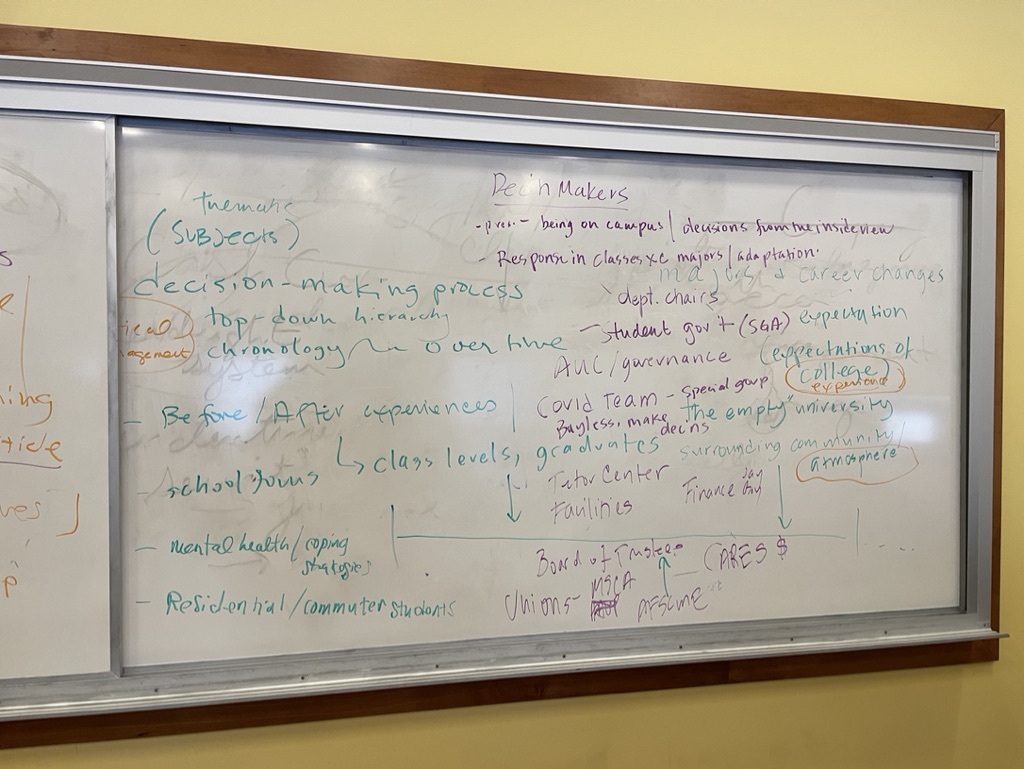
They formed four teams, each focused on a specific segment of campus: Administrative, Professional Degree Majors, Liberal Arts and Science Majors, and Campus Life (student organizations, athletics). Each team would generate their own set of interview questions, and they would all use the same permissions form. We also established a set of metadata to collect for each interview, housed in a tracking spreadsheet.
In setting up those documents, I provided them with the following resources:
- Tech and Interviews flow chart:
- Some additional suggestions for tech here: (I have a subscription to riverside.fm, which is like squadcastr)
- OHA Statement on Ethics: (adapt and identify specifics to this project – state what ethical considerations have been taken in the construction of this project)
- Sample Interview Questions:
- Tufts Covid-19 Questions
- Eastern Kentucky University Covid Questions
- Sample Release Agreement Form and Biographical Information; consent form I’ve used.
We set up a shared folder, a consistent file naming system, and tech recommendations. I gave them access to my riverside.fm account for recording remote interviews.
They set goals and a deadline for themselves — to finish all of the interviews by March 30.
While they conducted this work outside of class, for the most part, I began using class time to prepare them in thinking about what the “public-facing” aspects of this work might look like. I began asking for help on Twitter, and received many generous offers of assistance, plus a host of exciting examples to show them regarding what they might consider.
Wednesday, March 2, 2022
- Listen to this short conversation I had with an oral historian working on a similar project
- Listen to one episode of this podcast by historian Gillian Frank
I also assigned another writing piece, asking them to explore a digital. humanities tool:
Due in Class: Profile (750 words) of a digital humanities tool and examples of its use. (Consult lists here and here; conduct research to find an application of the tool and incorporate into your profile)
This got them thinking about what they might do with their interviews, especially since we created transcripts of each interview using otter.ai. Classes included daily check-ins on group progress, troubleshooting, and ensuring practices were working. I talked about open-ended questions, as well as trying not to interject too much when the speaker was talking, especially not if recording separate tracks, as this could introduce noise in any podcast use.
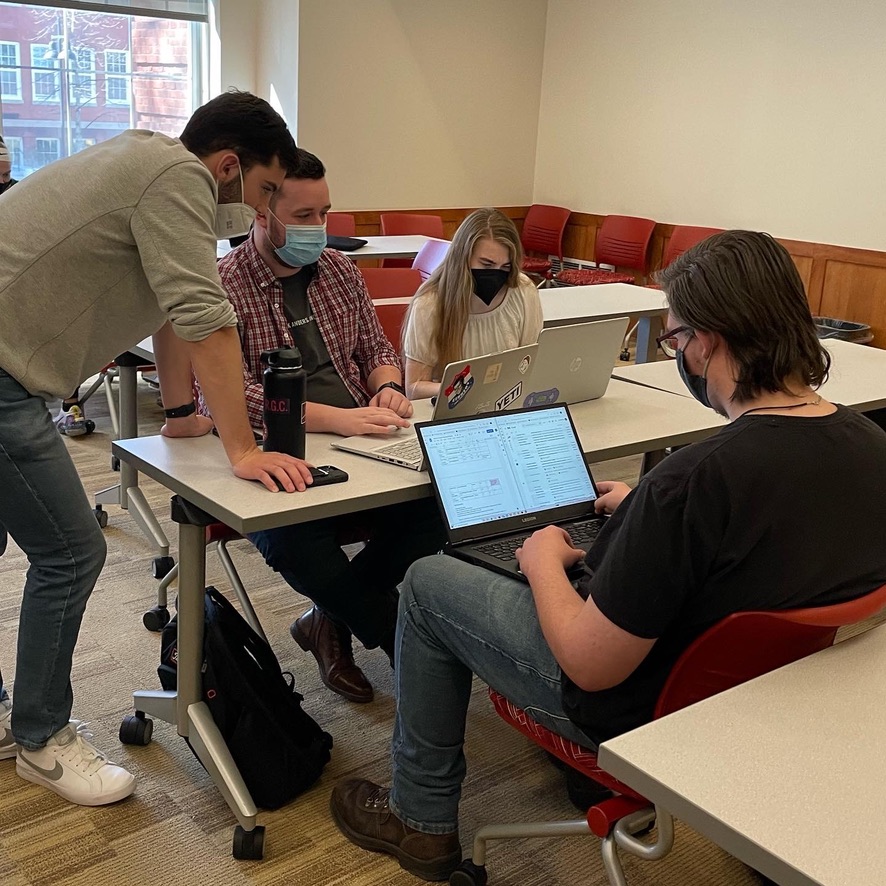
We benefited from the visit of Kisha Tracy, from English Studies, who engaged in an activity about using photographs to construct narratives. I had begun a related archiving project the previous semester, which crowdsourced photographs and documents, along with testimony, from the campus community. The Student Government Association continued this work (a number of members were in the class), and thus that collection grew as well. We looked at examples of Digital Public History exhibits. We also were grateful to have Gill Frank visit the class, who talked about oral history and podcasting, and gave the students a number of fantastic tips and whose own podcast Fern Hill inspired students further.
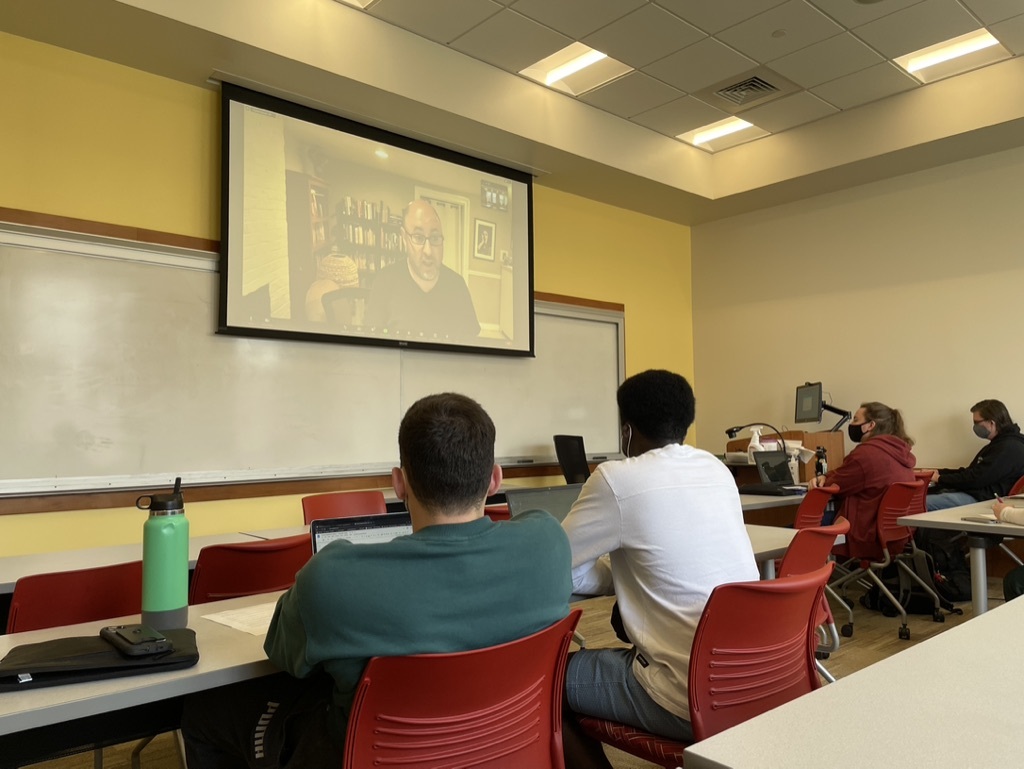
By early April, the students had collected most of their interviews, and so began to think about what to do with them. I left the option for how to disseminate these open — they could create an exhibit, a website, a podcast, focus on building the archive, or any number of other options.
The Brainstorming Process
We determined the next product by using “aggressively large” post-it notes, as one student explained.
I divided the brainstorming session into four prompts, which proved to be crucial.
The first established the wishlist — what they would do if anything were possible.
The asked them to reflect on the FOCUS of their public-facing work. It could focus on a narrative of their subjects, on the archive itself, or on them and their process (reflecting on what it was like to collect pandemic oral histories, having lived through it themselves).
I collected their post-its and arranged them based on where they places the bulk of their emphasis (see the continuum line at the bottom of the board). As this demonstrates, the majority of students wanted to focus on the subjects, their interviews.

But each post-it contained a lot of priorities and explanations, which I captured into a document defining the mission of their digital public history project.
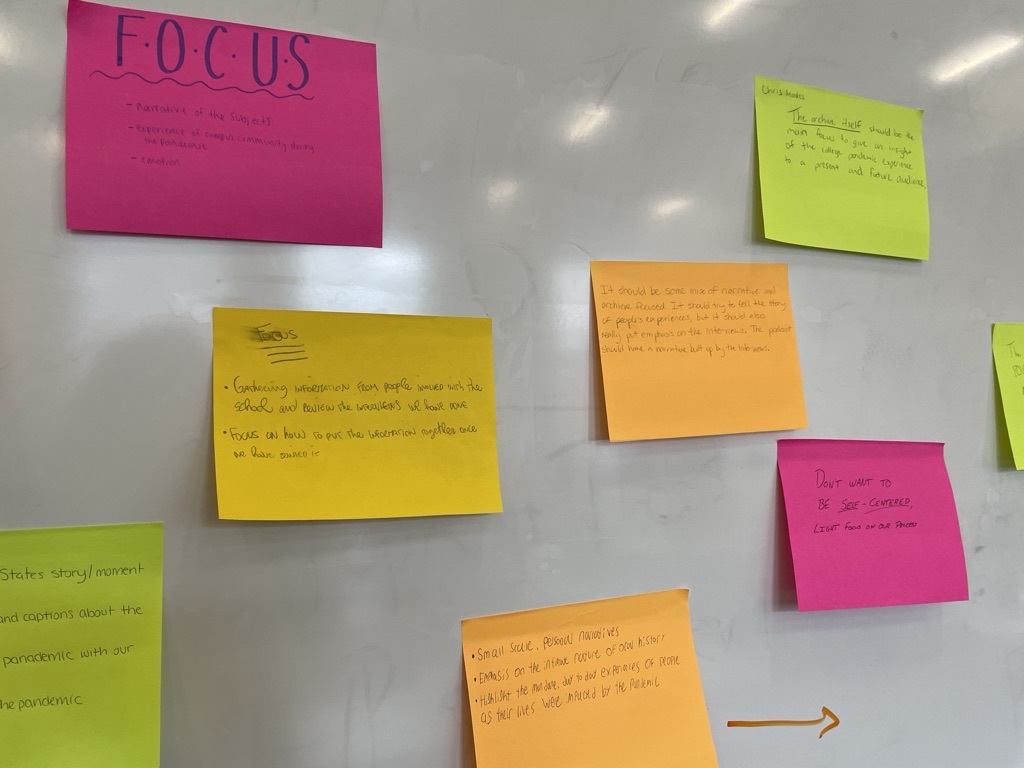
With the focus established, we looked at STRUCTURE next. I asked them what kind of structure they wanted for their product, or thoughts on how to balance that.
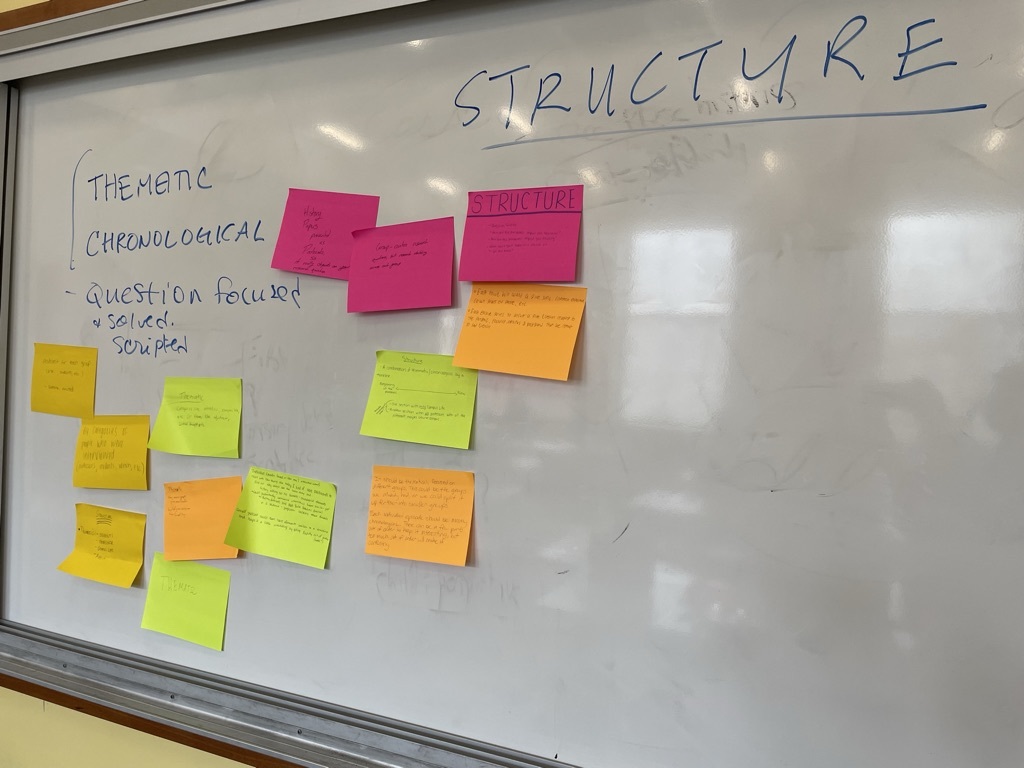
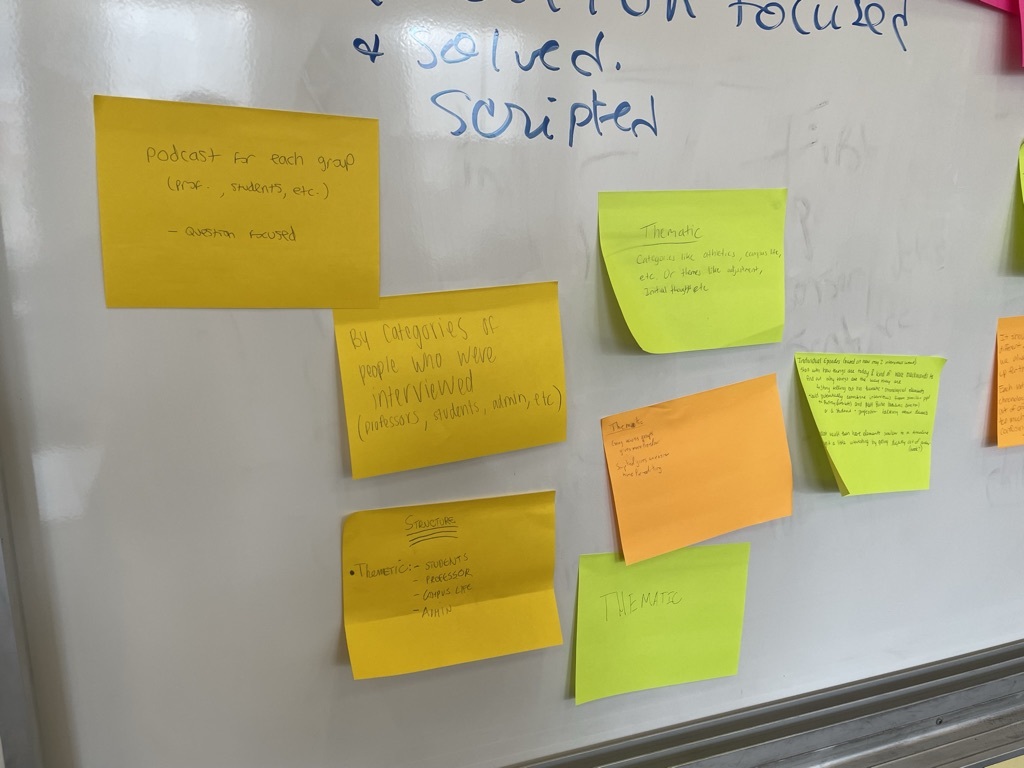
They wanted something that looked across their interview subjects to identify thematic connections, but which moved chronologically.
I don’t have a photo for it, but I also asked them about the BALANCE of PODCAST and EXHIBIT. Most of the class wanted about 70% podcast, 30% exhibit/website. That related to the last prompt, which was about LABOR.
I asked each student to write on the post-it what kind of responsibilities they were capable of taking on, considering their skills, commitments, workload, etc. I allocated 70% of the labor to the podcast, and 30% of the labor to the website, with a few special people dedicated to tasks they identified for themselves (one student said someone should look after all permissions and ethics to ensure we were not in violation, which I thought was a good idea! She also generated the Creative Commons license for the website and made sure each interview had a consent form–and helped the web team with their work, when not busy).
Podcast Production
April was thus dedicated to podcast production, with the teams reorganized and the labor reallocated. Two executive producers and a project manager, who was also responsible for setting deadlines and timelines, produced the scripts. Everyone went through a big document of the transcripts (which were not perfect) and allocated quotes into the the episode structure the producers identified. The producers then built their narratives from the suggested quotes.
An editorial team waited patiently for the scripts, while also focusing on their process. They set up a file naming structure for the clips, as well as divided the labor.
Once a script was produced, they would divide up the clips and process them, generating sequential files corresponding to the script. The producers recorded the narration to accompany the clips, which were then added in between the interview clips.
One student recorded theme music, even.
Meanwhile, the website/publicity team constructed a digital exhibit on their webpage, and cataloged the oral histories. I added the oral histories and the transcripts to Omega, using a data import from the tracking spreadsheet the students had used, which used Dublin Core metadata as the headers, making transferal very easy. The webteam also created the descriptions and branding for the podcast and the website.
Producing the scripts proved to be the most challenging aspect. Luckily, three seniors in History were in the class, who were experienced in how to structure and use evidence, as well as generating research questions to guide the exploration of each episode.
We had to use the last meeting, our exam block, to produce the final narration, and the final two episodes came together that last week.
The students understand that there is much more that could be produced from this, as well as many more interviews to conduct and interpretation to explore. (I hope to get some support so perhaps some of them can continue this work over the summer).
But in the end, we have five engaging and bracing episodes that get to the heart of the pandemic experience — it’s sad, shocking, humorous, and captures the boredom, fear, isolation, and heavy workload and uncertainty the pandemic wrought. It is my hope that like other public history, it sparks further conversation across the Fitchburg State community about what these events have meant, and how community has changed as a result.
What they produced is a work of history, but it is also a document of this moment, capturing how college students–who lived through this–placed emphasis on certain aspects of the pandemic, as well as interpreted what they went through. They gained experience in research, information management, organization, project management, teamwork, analysis, creativity, ethical considerations, and communication — as well as exploring what it means to produce digital public history.

Leave a Reply